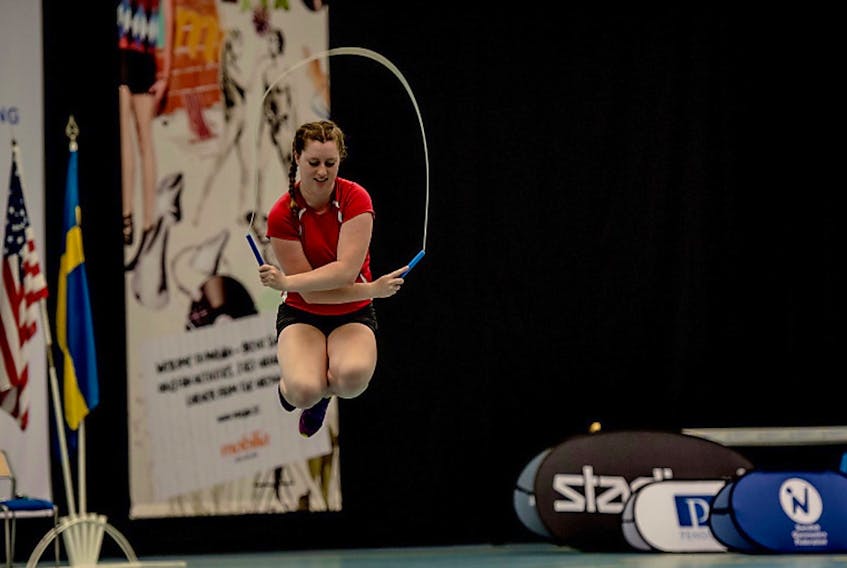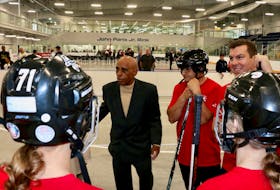As children, most people were given a jump rope in gym class and taught how to make it pass once under their feet. Competitive skipping provides a little more of a challenge.
“I really like the power side of the sport, like donkey kicks, pushups and flips. They are my strong suit,” says Hanna Janes, a Grade 11 student at Auburn Drive High School in Dartmouth, N.S.
Janes has been skipping competitively for the last seven years with the Porters Lake club Jump Energy. She says designing freestyle routines, where those flips and handstands come into play, is a difficult element of the sport.
“It is hard trying to get the routines as clean as possible with no mistakes,” says Janes. “If something goes wrong, it is not just one person, it is the entire system.”
Freestyle is one of the main categories of jump rope competition. The other is speed. Skippers participate in several freestyle and speed events that differ by things like time, number of skippers, number of ropes and overall difficulty. Athletes enter competitions with their club but compete in teams of four to five or as individuals.

Two years ago, at nationals, Janes’ individual team was in the middle of a double-Dutch speed event when something unexpected happened.
“We had one of the ropes break - like one of the double-Dutch ropes we were using for the event - so we had to do a re-skip,” says Janes.
They ended up getting the highest score of the competition and was awarded the first-place grand national award for double-Dutch speed relay.
She said afterwards, as one of the turners, her arms were really sore.
Victoria Day weekend would have been Janes’ seventh time at nationals, and her last chance before she plans on starting university to qualify for team Canada and the world championships. Cancelled because of COVID-19, she is hoping they move the qualifiers to 2021.
National stage
Kristyn Ball, a former Jump Energy athlete, had the chance to attend five world championships. Between 2010 and 2018, she competed in places like Loughborough, England, and Shanghai, China.
Ball skipped for over 10 years, taking a step back to go to Nova Scotia Community College for therapeutic recreation. She is graduating this year. One of her favourite things about the sport is coming up with the freestyle routines, saying it is how the team really comes together.

Ball has always enjoyed competing and bringing those routines to the floor, but as she grew older, she also gained an appreciation for the sport’s atmosphere.
“No matter if you are competing nationally or internationally, everyone around you is just so friendly,” says Ball. “It is really nice you don’t have the stigma of ‘I need to beat you’ kind of thing.”
The world championships for jump rope happen every two years. This year’s championship was to take place in Ottawa later this summer but was moved to 2021 because of COVID-19. The competition will be the first international world championships put on by the International Jump Rope Union (IJRU). The organization was formed in 2018 with the merger of two international skipping organizations.
By merging, the IRJU became a member of the Global Association of International Sports Federations. Plus, by having only one international body, jump rope is one step closer to becoming an Olympic sport.
All ages
Bill Williams has never competed in a world championship, but his oldest daughter has. Watching her compete with Jump Energy, then called the Eastern Shore Mariner Skippers, gave him and some other parents an idea.
“We got into it for fitness first and then we said, ‘well, why don’t we just compete like the kids’,” says Williams.
He competed for a total of five years, two to three times provincially and twice nationally.
“Provincially I did well, I usually finished first or second. I did win the nationals in Windsor, Ontario, I won the freestyle for over 35 male. There were only three of us in it, though.”
Williams is a competitive person and wanted to see how well he could do in the sport. At 42, he says he was not as coordinated or flexible as the younger competitors, saying jump rope is a physically demanding sport.
Monica Harlow, who competed with Williams’ daughter, echoes that sentiment.
“I don’t think people really understand it until they see it,” says Harlow. “We are just as much athletes as anyone else that would compete at an international level, or hopefully someday, at an Olympic level.”
Rare bond
Harlow skipped from the time she was six until she was 24, including while attending university and two years of working full-time. She says jump rope offers a rare bond between athletes that isn’t seen in most sports. This is in part because they practice as a club.
“At a younger age, you would really have these people to look up to that were always present. Then when you get older, you had little ones looking up to you,” says Harlow.
In competitive skipping there is a lot of travel involved, including the younger skippers. Harlow went to her first national competition when she was six years old. She says travel is another time older skippers really step into a mentorship role for their younger teammates.
“You have to really keep a close eye on them. Mentor and coach them and teach them how to behave and what competition is like,” she says.
Like Harlow, both Janes and Ball really enjoyed the coaching role they were able to take on as they got older. Both women helped coach while skipping and hope to return to it in the future.
“I would really like to get back into the coaching role, to give back and share my knowledge to everyone on the team still,” says Ball.
How to get involved:
Anyone interested in trying jump rope themselves can check out the Rope Skipping Association of Nova Scotia’s website for more details. There you can find information and contacts for the different jump rope programs available. Programs include Rockin The Ropes, which is put on by the Lake & Shore Community Recreation Society between January and May. The program runs once a week and teaches children six and older the basic skills of jump rope through instruction and games.
On top of the competitive programs, Jump Energy also provides a pre-competitive program, which runs once a week starting in the fall. In the pre-competitive program, skippers get to work closely with a competitive jumper so they can learn fast and get clear instructions. From there, members can be moved up to the competitive program. The competitive program runs practices three times a week.









